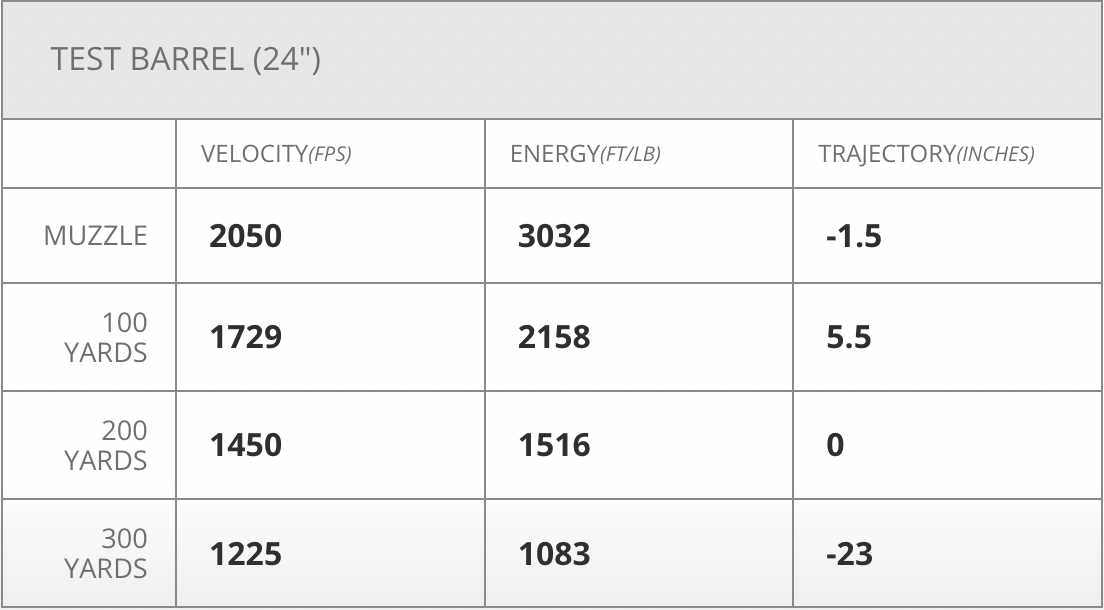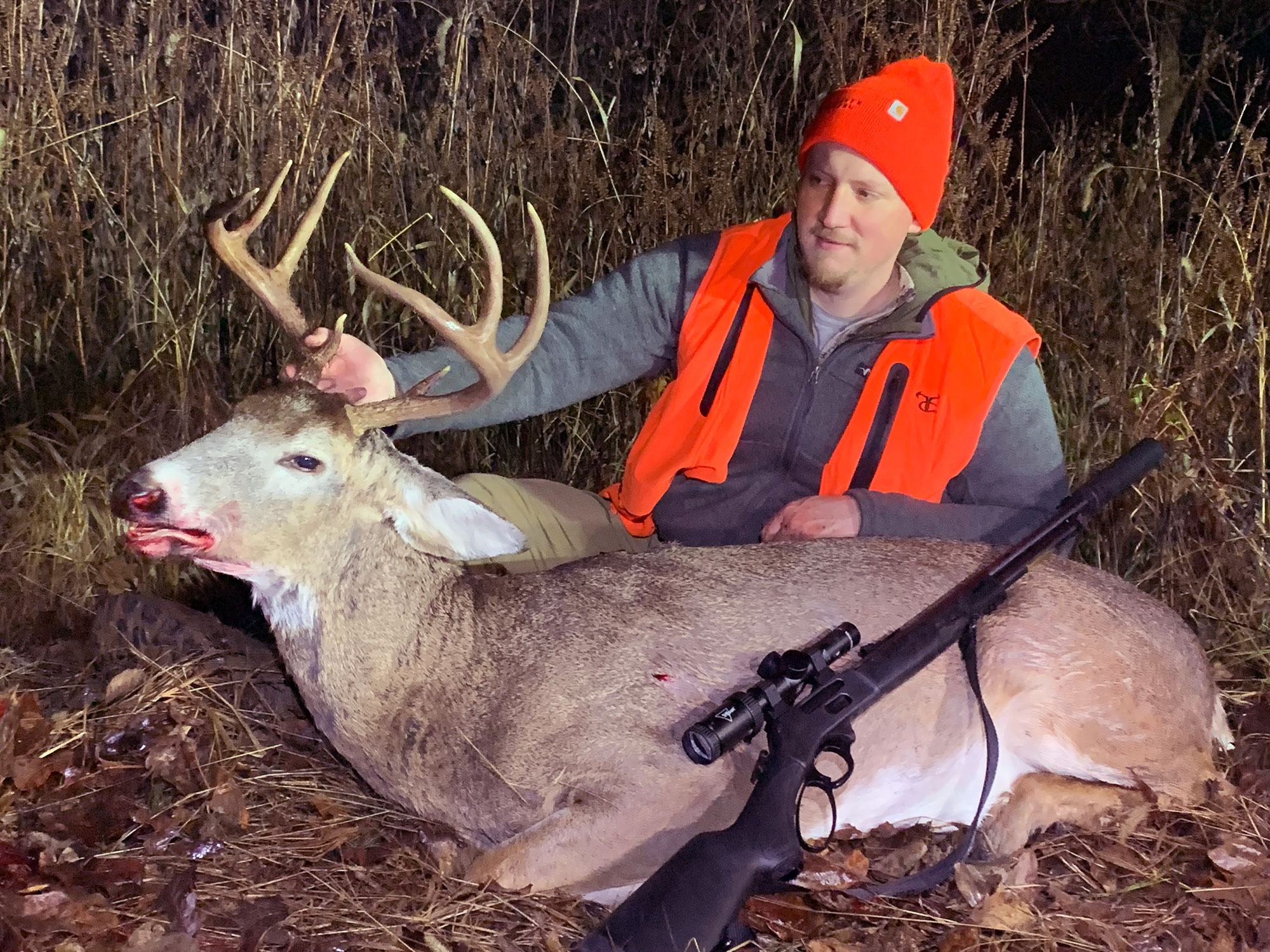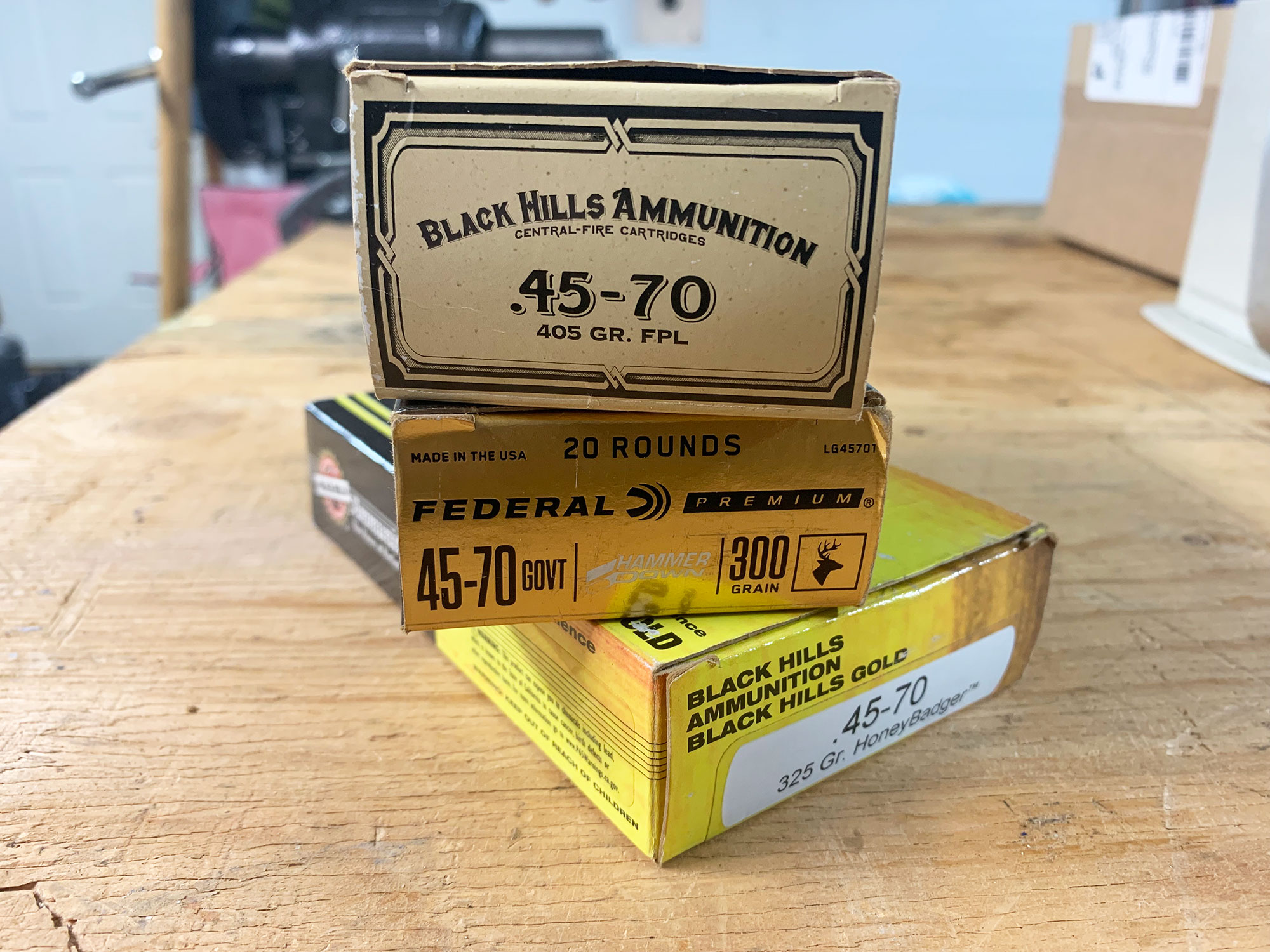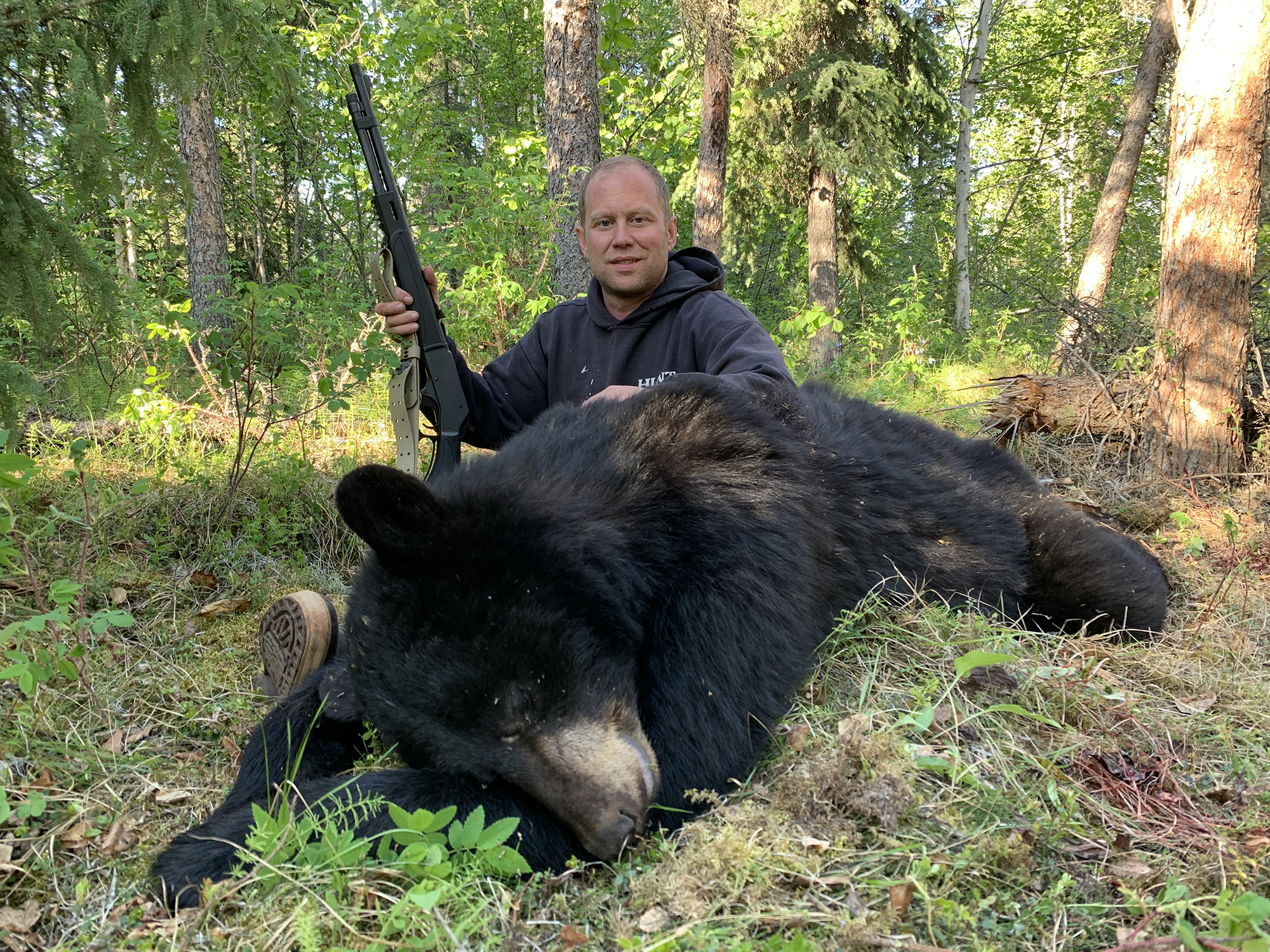We may earn revenue from the products available on this page and participate in affiliate programs. Learn More ›
The lever-action rifle is both a symbol of American history and a working platform that continues to entice modern shooters. That’s because lever actions are reliable and downright fun to shoot, whether you are ringing steel at the range or hunting screaming bull elk in the dark timber. Cartridge selection for lever-action rifles has evolved with time. However, there are still two iconic cartridges that carry the day, and they have duked it out for more than a century: the .45-70 vs .30-30. Is one really better than the other? Well, that depends on who you ask.
Few will argue against the close-range terminal performance of either the .30-30 Winchester or the .45-70 Government as they both tout impressive track records in the field. With that said, there are some major ballistic differences between the two cartridges. So the question shouldn’t be which one is better, but rather which one is best suited for your needs. I’d argue you should have lever guns chambered in both cartridges. But if you insist upon deciding between the two, here’s what you need to know.
History
Origins of the .45-70
While the .45-70 is synonymous with lever-action rifles, the cartridge made its debut in the breech-loaded single-shot 1873 Springfield rifle following the American Civil War. The new .45-caliber cartridge was typically loaded with either a 405- or 500-grain cast lead bullet backed by 70 grains of black powder. Back then, new cartridges were simply named by the caliber of the projectile followed by the weight of the powder charge, hence the .45-70. The “Government” designation simply came from being designed at the government-run Springfield Armory in Springfield, Massachusetts.
The success of the ballistically superior (at the time) breech-loaded .45-70 spread like wildfire. It wasn’t long before hunters took to the new cartridge. Eventually, outdoorsmen had a wide variety of rifles to choose from as manufacturers produced more and more single-shots and lever-actions chambered in the cartridge.
Since then, there have been several .45-caliber cartridges released that are ballistically superior to the old .45-70. However, 150 years later, the .45-70 Government continues to be a staple among lever-action enthusiasts.
Origins of the .30-30 Winchester
In 1895, 22 years after the launch of the .45-70, Winchester Repeating Arms introduced the .30 WCF (Winchester Center Fire) which is now commonly referred to as the .30-30 Winchester. Like the .45-70, the .30-30 name is derived from the .30 caliber projectile being propelled by 30 grains of smokeless powder. Early ammunition for the .30-30 featured a 160-grain bullet being pushed just under 2,000 fps, giving hunters a substantial advantage in terms of trajectory and terminal performance when compared to other popular cartridges of that time.
Winchester strategically coincided the launch of the .30-30 cartridge with their Model 1894 lever-action rifle which offered hunters a reliable rifle at an affordable price. Popularity of the Model 1894 chambered in .30-30 spread across the country and it quickly gained a reputation as one of the most popular and viable hunting rifle and cartridge combinations.
You’ll still see the combo in modern hunting camps. To this day, my father has both his father’s and grandfather’s lever action .30-30s in the safe dating back to the early 1900s. Though their adventures predate me by many decades, my imagination runs wild every time I pull those rifles from the safe. Oh, what I would give to hear the stories those .30-30s could tell. From a purely nostalgic perspective, I hope to one day take an old mule deer in the vast sage-covered hills of western Wyoming, the same way my forefathers did nearly a century ago.
Ballistics
When the .30-30 hit the market, it was ballistically superior to the .45-70, which originally fired a bullet in the 405-grain range at only about 1,250 fps. But modern .45-70 loads and the rifles that fire them are much more competitive, as you’ll see below.
For this story, we’ll stick with the modern iterations of the cartridges. Given the differences in bullet diameter and case dimensions of the .30-30 and .45-70, it comes as no surprise that the two cartridges vary dramatically in ballistic performance. Comparing these two cartridges is a perfect example of choosing between lighter, faster bullets and slower, heavier bullets. Both have their pros and cons, and depending on where and what you are hunting, chances are one of these cartridges will fit your pursuits better than the other.
.45-70 Ballistics
Modern .45-70 bullets range dramatically in weight between 250 and 500 grains with 300- to 400-grain projectiles being the most common. With slugs that size, it comes as no surprise that the .45-70 is made to hit its target like a freight train.
It is not a long-range round. Effective range with most .45-70 rifles will be inside of 200 yards with an extremely competent marksman being able to stretch it out to 300 yards in a hunting scenario. Hornady’s LEVERevolution ammunition loaded with a 325-grain FTX projectile is a perfect combination of the range and power of the .45-70. This Hornady load produces a muzzle velocity of 2,050 fps with a walloping 3,032 ft/lbs of energy at the muzzle. At 200 yards, this same load is still delivering an impressive 1,516 ft/lbs of energy with only 5.5 inches of drop between 100 and 200 yards. However, speed and performance drop off dramatically beyond 200 yards. At 300 yards the 325-grain slug will drop another 23 inches and deliver 1,083 ft/lbs of energy.

Read Next: The New Marlin 1895 SBL .45/70 Rifle Is the Best Lever-Action in the Company’s History
.30-30 Ballistics
The .30-30 shoots much lighter projectiles ranging in weight between 140 and 190 grains. Despite the much lower case capacity and powder charge in the .30-30, when compared to the .45-70, it is able to deliver adequately sized projectiles on a much flatter trajectory. In an effort to compare these cartridges as closely as possible, let’s look at Hornady’s .30-30 160-grain offering in their LEVERevolution line. This particular load produces a velocity of 2,400 fps and 2,046 ft/lbs of energy at the muzzle. At 200 yards, the 160-grain bullet only drops 3 inches and hits its mark with 1,304 ft/lbs of energy. At 300 yards, the bullet only drops an additional 12.1 inches (compared to the 23 inches of drop from the .45-70). The 160-grain bullet fired from the .30-30 produces 1,025 ft/lbs of energy at 300 yards, only 58 less ft/lbs of energy than the 325-grain slug fired from the .45-70. In the wide-open spaces of the West, it is easy to see why the .30-30 became popular in its day.

Read Next: Marlin 336 Classic Review and Field Test
Recoil
It should be no surprise that the .45-70 produces substantially more recoil than the .30-30 simply due to the heavier projectile. Recoil will vary depending on which ammunition you shoot, but average recoil for the .45-70 hovers around 29 to 30 ft/lbs while the .30-30 typically produces 12 to 14 ft/lbs of recoil. That sounds like a drastic difference—and it is. For perspective, when compared to modern cartridges, the .45-70 produces similar recoil to that of your favorite .300 Win. Mag.
On many modern .45-70 rifles, recoil can be mitigated with muzzle brakes and suppressors. However, if you are shooting a vintage lever action in either of these cartridges, chances are the butt-pad will be slim to non-existent. The wood stocks of years gone by, paired with a healthy punch of recoil, can knock even a sturdy rifleman into a daze.
Accuracy
Both the .45-70 and .30-30 were considered precision cartridges in their time but would fall short of that definition nowadays. Sub-MOA lever-action rifles are few and far between but for practical purposes of the platform and these cartridges, that level of accuracy isn’t necessary. With an effective range inside 300 yards, even a rifle producing 2 MOA groupings will be more than adequate in the field.

Terminal Performance
Both the .45-70 and .30-30 deliver good of terminal performance at moderate ranges. The .45-70 excels in close-quarter hunting, delivering a massive projectile and transferring a tremendous amount of energy. The .45-70 thrives in the dense deer woods of the Northeast as well as the dark-timbered mountains of the Pacific Northwest and Alaska for hunters chasing elk, moose, and bears.
On the flip side, the .30-30 delivers projectiles ideal for deer hunting out to 300 yards and requires less holdover for longer shots. The .30-30 certainly has the ability to take down elk-sized game if necessary but thrives in mid-range deer hunts. While I have not taken a deer myself with this cartridge, the stack of mule deer racks pinned to the back of my grandfather’s barn is a testament to the cartridge’s capabilities.
Ammunition Availability and Selection

The availability of ammunition for both of these cartridges is unfortunately limited when compared to more modern cartridges. However, both are generally readily available both online and at retail locations. The average cost for a box of .45-70 ammunition hovers around $60 while the average cost for a box of .30-30 ammunition is typically around $35, which should be considered quite affordable in today’s ammo market. The difference in price is directly tied to the size of the bullet and case between the two cartridges.
Depending on your intended use, most major ammo manufacturers offer several variations in projectile weight to fit your needs.
Final Thoughts on the .45-70 vs .30-30

With the rapid progression of new cartridges, some hunters want to return to our hunting roots. I’ll admit that I’m among the first to use the latest and greatest shooting advancements to increase my odds of success in the field. However, I still yearn for a connection to my ancestors and vintage cartridges and rifles are an obvious and tangible conduit. Regardless of your hunting heritage, both of these cartridges offer ample opportunities to connect with the past and carry on hunting traditions.
Given the impressive track record of both the .30-30 and the .45-70, I have a hard time imagining that either of them are going away anytime soon. When possible, look for opportunities to utilize these iconic cartridges in your own hunts. I’m planning to do the same.
